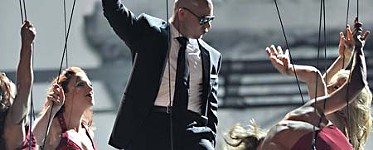TV Eye
The Politics of Dr. Seuss
By Belinda Acosta, Fri., Oct. 22, 2004

(Courtesy of the Library of Congress / Al Ravenna / ITVS)
Independent Lens, the acclaimed film anthology, returns with a fresh roster of independent documentaries and features sure to illuminate, entertain, and, in some cases, surprise. Opening the new season is The Political Dr. Seuss, Ron Lamothe's film on the life and work of Theodor Geisel, otherwise known as Dr. Seuss. The renowned children's book author (1904-1991) wrote 44 children's books, starting with And to Think That I Saw It on Mulberry Street (1934), followed by a slew of lovable favorites like The Cat in the Hat, How the Grinch Stole Christmas, and many, many others. His dewy-eyed, spoon-shaped creatures, playful language, and goofy situations not only made him a friend to children, but also revolutionized the way young children learn to read.
The loopy gregariousness of Dr. Seuss books made him a pied piper for children. But Geisel was an intensely private and shy man who avoided the limelight. Lamothe's film does much to expand the writer's public biography with the assistance of several talking heads: biographers, friends, associates, and his second wife, Audrey.
Though he graduated from Dartmouth and found himself at Oxford with the intention of becoming an English literature professor, Geisel found his studies a bore. To amuse himself, he "noodled," using images instead of words to capture ideas, an early indication of how he was "excited about marrying words with pictures" to create something more interesting than either. Fortunately, a series of fateful events led him to drop out of Oxford to seriously pursue cartooning. Soon, magazines sought his unique style and wit – most notably the leftist publication PM and the humor magazine Judge. His editorial cartoons for these publications were sharp critiques of anti-Semitism and bold condemnations of racism that were considered cutting-edge in their day. After he made an offhand reference to a popular bug spray, the advertising world came calling, providing Geisel a lucrative 17-year career.
It is to filmmaker Lamothe's credit that he does not gloss over the less flattering aspects of Geisel's career: making Army training and propaganda films during and after World War II with Hollywood filmmaker Frank Capra (and cartoonist Chuck Jones). As in other media of the time, the depiction of the Japanese in these films was deplorably racist. Yet, Lamothe includes this information without malice, giving viewers a full spectrum of his work and showing how this period was necessary to create Dr. Seuss.

(Mandeville Special Collections, University of California, San Diego / ITVS)
What endears Geisel to his readers, of course, are his books. These, in addition to his early editorial cartoons, explain why the word "political" is in the film's title. As the film's interviewees explain, Geisel's work ranged from the mildly subversive to the overtly political. The core message in all of his books is "It's fine to be different, but better to do good." More overtly political works like The Lorax and The Butter Battle Book champion environmentalism and examine cultural differences. He wrote Horton Hears a Who! as a parable about the American postwar occupation of Japan, while Yertle the Turtle is a critique of unchecked power, using Hitler as a model. But even if these lessons are not recognized, what readers of all ages appreciate most is the fun Dr. Seuss brings to the page.
While Lamothe's film offers an illuminating portrait of Dr. Seuss, the film seems constricted by a sense of duty to tell his story well. The film jumps to life when the talking heads shed their expert personas to read from Geisel's last work, Oh, the Places You'll Go! At this point, the film's tidiness falls away, as each reader becomes animated by Dr. Seuss' language. In the end, this is the clearest explanation of what makes Dr. Seuss books loved and read today.
The Political Dr. Seuss airs Tuesday, Oct. 26, at 9:30pm on PBS. Other Independent Lens films confirmed to air in Austin include:
"Polka Time" (directed by Lisa Blackstone). Polka lovers from around the world gather yearly in Gibbon, Minn., to share their love of the dance and their hopes for its continuing future. Airs Tuesday, Nov. 9, at 9:30pm.
Afghanistan Unveiled (directed by Brigitte Brault and the AINA Women's Filming Group). The effects of war, the Taliban, and U.S. interventions are examined in footage collected by a team of first-time women video journalists trained in Afghanistan. Airs Tuesday, Nov. 16, at 9pm (note earlier air time).
Los Angeles Now (directed by Phillip Rodriguez). A portrait of the second largest city in the U.S., which has gone from being predominantly white to a multicultural, sometimes disorienting megalopolis. Airs Tuesday, Nov. 23, at 9pm.
For a complete list of the Independent Lens season and full descriptions, go to www.pbs.org/independentlens/guide.html.








